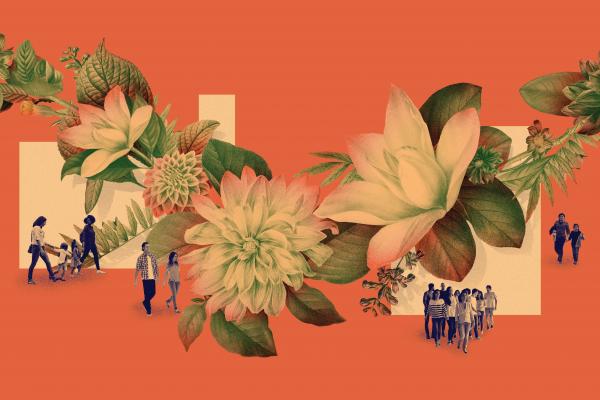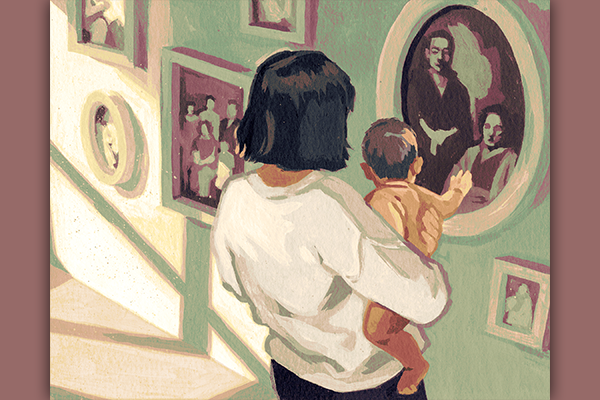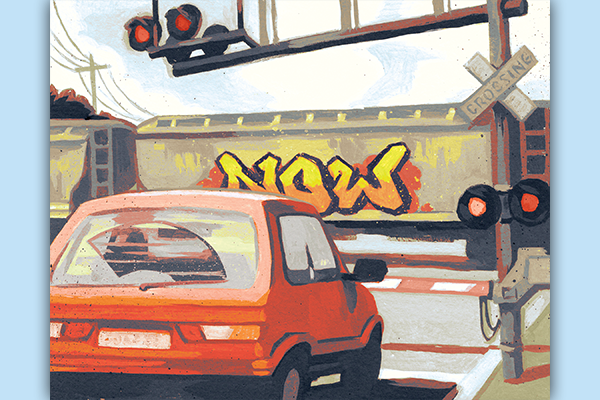"WE WILL MAKE you humble,” the superior in the Catholic order told me. I was 18 years old and had just joined a community of Catholic women religious.
We were eating dinner, and I was excitedly telling her and the other sisters what I had learned in theology class. A sister asked me, “Do you want to be a theologian?” Without hesitation, I answered “yes.” She shot a quizzical look at the superior, who said, “Being a theologian is likely to make you proud and arrogant. Don’t worry—we will make you humble.” She and the others smiled knowingly. Confused and hurt, I shut up.
Becoming a theologian was not something that I wanted to do for prestige. It was what I felt called to do; it was, and is, my vocation. As is usually the case in stories like this one, not all the sisters agreed with the superior’s comment.
Later that evening, one of the older sisters approached me as I was studying in the convent library. She put her hand on my shoulder and said, “Little sister, do you know what humility is?” Before I could reply, she said, “Humility is the truth.” Then she pointed at my books and notes. “The truth is that you love to study, question, think, and write. The truth is that these are the gifts God has given you. So be humble: Accept them and do something with them for the greater good.”
My life has taken me far from that convent library, but I’ve never forgotten her words because they freed me. After all, isn’t that what truth does? It sets us free. But free from what?
Humility is not humiliation
Keepers of Christian tradition have often fed a lie to women and other members of historically marginalized communities that exercising the virtue of humility (“being humble”) means keeping our heads down and our mouths shut. But this is false humility.
False humility functions to protect the status quo. It slyly whispers to us: “Don’t rock the boat,” “It’s not your problem,” or even worse, “It’s just the way it is.” False humility tells us to accept sexism, racism, and other social evils as part of the “cross” we or others must bear. False humility chews away at the root of justice, which is truth.
Humility—real humility—is the truth. Authentic humility enables us to see and acknowledge the truth of a person or situation, including ourselves. We cultivate humility as a personal virtue by first engaging in critical self-reflection, acknowledging our strengths as well as the places where we need to grow.
How do we too perpetuate the lies of false humility? What are the sites of privilege we occupy that need to be examined? Lest we get stuck in shame and guilt, humility reminds us that, in Christian tradition, no one is innocent. We are all called “to go our way and sin no more.” We are all invited to use our gifts and our privilege for the work of justice. In this way, humility can also be a collective virtue. It can lead us toward the common good. Humility can set us all free.
Owning truth or picking up stones?
It is fitting that Jesus’ comment “You will know the truth, and the truth will make you free” (John 8:32) comes in response to consistent questions regarding his identity. Jesus has engaged in critical self-reflection; he knows who he is and who has sent him. He is not seduced by the lies of false humility.
John 8 begins with the story of the woman “caught in adultery.” It’s early morning at the temple and the crowds have gathered around Jesus to hear him teach. “The scribes and the Pharisees brought a woman who had been caught in adultery” (verse 3). They forced her to stand before the whole crowd. To test Jesus and trick him into some actionable offense, they said: “Teacher, this woman was caught in the very act of committing adultery. Now in the law Moses commanded us to stone such women. Now what do you say?” (verses 4-5).
Jesus doesn’t take the bait. Instead, he bends down and writes on the ground. They persist in questioning him. Finally, Jesus answers them: “Let anyone among you who is without sin be the first to throw a stone at her” (verse 7). Not the answer they were looking for, not the answer they had been taught, but this is the answer that Jesus gives them—and gives us.
After the accusers skulk away one by one, Jesus engages this unnamed woman in conversation. As a feminist theologian, I find this interaction striking. He is the only one in the story who asks to hear her voice. “Woman, where are they? Has no one condemned you?” he asks. “No one, sir,” she replies. Jesus says, “Neither do I condemn you. Go your way, and from now on do not sin again” (verses 10-11).
Jesus does not shame her; he does not humiliate her. Jesus knows the difference between humility and humiliation.
While humiliation leaves us wallowing in shame, humility promises that we are still redeemable. In the case of the woman caught in adultery, the truth of the situation is that it is unjust: Where is the man with whom this woman was “caught in the very act of committing adultery”? Why is he not being condemned to die? (Hint: sexism.) Further, how do we know whether this woman was engaging in a consensual sexual act or was being assaulted?
The religious leaders who bring her before Jesus presume she is guilty, but Jesus is not so quick to judge. Instead he speaks truth: Who among us has no sin? Who among us does not long for forgiveness, rather than condemnation? He acknowledges sin but he doesn’t see this sin as irredeemable. Jesus believes that we are capable of change.
These are the truths that make us humble; these are the truths that set us free.
Throughout John 8, Jesus defies expectations. He bluntly tells those who try to define him that they don’t know him—and they don’t know the God he calls “Father” (verses 12-20). Like its opening story of the woman caught in adultery, the chapter ends with folks ready to throw stones, though this time (verse 59) they pick up stones to throw at Jesus!
Can we exercise collective humility?
Being humble, being truthful, does not make us popular. It is revolutionary, and it can be very dangerous. What must we risk to be humble? What are current injustices that might be remedied by humility?
For example, news reports have focused on the inhumane conditions faced by women, children, and men who have recently crossed the U.S.-Mexico border seeking political asylum. After families are separated from each other, individuals are placed in “camps” with unsanitary conditions, including children kept in cages. There are reports of rampant sexual abuse of adults and minors. Children separated from their parents can be heard weeping inconsolably. Some children have died because of maltreatment.
While many in the U.S. and around the world protest these injustices, President Trump and others argue that immigrants should stay in their own countries and follow the proper protocol for immigrating to the United States. Television shows pit “liberal” Democrats against “conservative” Republicans only to have the “conversation” on immigration laws devolve into immature name-calling and silent stonewalling. How might the virtue of humility, of truth, remedy this situation?
Perhaps those who call themselves “Americans,” regardless of political affiliation, might officially acknowledge our collective and complicated national history. We could start by recognizing these truths: The United States is a nation built on the genocide of Indigenous peoples and through the labor of enslaved Africans and African Americans. Historically, we have already engaged in the heinous practice of separating families. African-American children were ripped from their parents and sold into slavery. Indigenous children were forced into government-run boarding schools, whose mission was to eradicate the “Indian” in them. What, if anything, have we learned from these experiences?
Although difficult, acknowledging these painful truths might help us embrace and exercise a collective humility.
Mestiza consciousness rejects dualism
The work of Chicanx theorist and activist Gloria Anzaldúa provides examples of collective humility. In a process of collective acknowledgment, we might understand that there is no “us” and “them.” Instead, there is “nos/otras.”
Anzaldúa uses the term “nos/otras” to recognize that “the other” (otras) is always already a part of “us” (nos) and we are always already a part of them. It’s a term that shifts our subjectivity.
Anzaldúa is best known for her theorization of borderlands, which refers to the actual U.S.-Mexico border as well as a type of consciousness. In Borderlands/La Frontera, Anzaldúa writes, “The U.S.-Mexican border es una herida abierta [is an open wound] where the Third World grates against the first and bleeds. And before a scab forms it hemorrhages again, the lifeblood of two worlds merging to form a third country—a border culture. Borders are set up to define the places that are safe and unsafe, to distinguish us from them. … The prohibited and forbidden are its inhabitants. Los atravesados [the crossers] live here: the squint-eyed, the perverse, the queer, the troublesome, the mongrel, the mulato, the half-breed, the half dead; in short, those who cross over, pass over, or go through the confines of the ‘normal.’”
For Anzaldúa, the violence of the borderlands is foremost the violence of dualism. Dualism, in her understanding of it, privileges one identity category, one life, one group, over an “other.” It’s an “us vs. them” mentality that, she argues, is the root of all violence.
The paradox of the borderlands is that while it threatens to tear one apart, it simultaneously teaches one to recognize the inadequacy of dualistic categories. Transformation, Anzaldúa believes, can come through the development of a “borderlands (or mestiza) consciousness”—a form of consciousness that resists dualistic ways of thinking and being.
Although her initial theory of borderlands consciousness drew explicitly on the experiences of people who share mestizaje as a racial and ethnic heritage (the “mixing” of Spanish and Indigenous people), Anzaldúa’s later writings expanded borderlands consciousness to include all people who find themselves trapped between conflicting markers of identity.
She writes, “Our goal is not to use differences to separate us from others, but neither is it to gloss over them. Many of us identify with groups and social positions not limited to our ethnic, racial, religious, class, gender, or national classifications. Though most people self-define by what they exclude, we define who we are by what we include.”
A borderlands consciousness can enable humility because it seeks truth.
First, it calls nos/otras to engage in critical self-reflection. We must ask ourselves: What are our strengths? What are our shadows? How are they interwoven? Second, it asks us to acknowledge our suffering and the suffering of others: the pain of nos/otras. We ask: How am I contributing to this? How am I healing it?
Eventually, we learn to “define who we are by what we include.” We begin to see ourselves in the people and things we once believed were outside of us: the sister who vows to make us humble; the woman caught in adultery; the child crying in a cage; the guard at a border camp.
It is much easier to exclude the other, to say that the law of Moses or the law of the land instructs us to condemn them. It takes courage to say, “Let anyone among you who is without sin be the first to throw a stone.” And to realize that what we have learned to hate is also within us. But this truth sets nos/otras free to go and sin no more. It reminds nos/otras that we are capable of change.

Got something to say about what you're reading? We value your feedback!







